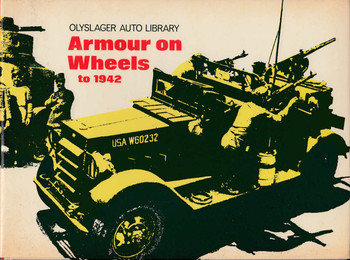Description
Compiled for The Olyslager Organisation by Bart H. Vanderveen, Hardbound, 64 Pages, First Edition, 1981, ISBN: 9780723227786 **RARE BOOK IN EXCELLENT CONDITION**
If it ever it came to selecting the world's most famous automobile, the Jeep would probably stand as good a chance as Henry Ford's legendary Model T.
The Model T, popularly known as Tin Lizzie, was, in its day, a world mater because it motorised millions of people and initiated mass production techniques. It was usually black in colour and open in design. The ubiquitous 'Truck, +-ton, 4 x 4, Command Reconnaissance' governmentese for Jeep) helped win a world war and afterwards was used for 1001 peaceful jobs. It was usually olive-drab in colour and open n design. Both were spartan, unsophisticated and uncomfortable but also rugged, reliable and virtually indestructible.
Tin Lizzie was discontinued in 1927 after a production run of over 15 Million in 19 years because it had become hopelessly outdated. The Jeep, however, is still with us after more than 40 years and attempts to ,otter it fundamentally have proved unsuccessful. In fact, the most iopular light 4x4 cross-country vehicles of today vary little in design tom the famous originals, many of which are still in use all over the world. Moreover, one can encounter two virtually identical military Jeeps, yet with a difference in age of a quarter of a century.
The extraordinary fact about the Jeep is that nobody invented it. lather, it was the end product of many years of endeavour to meet a long-standing military requirement for a light four-wheel drive general impose vehicle and scout car. Soldiers and civilians alike (and the Mlodel T in militarised form) were involved in this lengthy process which culminated in June 1940 when the US Army drafted a specification and invited no fewer than 135 manufacturers to bid. At first only two showed Merest: the American Bantam Car Company of Butler, Pennsylvania, Ind Willys-Overland of Toledo, Ohio. Ford came in later. Only Bantam would meet the time limit set by the Army; nobody could meet the weight limit which, at 1300 lb, was ludicrous (and was later increased). Pilot node's were submitted for test in late 1940 by Bantam, Willys and Ford, in that order.
There are several schools of thought on how the Jeep came by its tame. It was not new for during the late 1930s several multi-purpose vehicles were named after `Jeep', the 'Popeye' cartoon figure 'which was neither fowl nor beast, but knew all the answers and could do most anything'. In 1940-41 the +-ton Command Reconnaissance (Dodge) was often referred to as 'Jeep' and the +-ton as 'Peep', but from 1942 the tame Jeep was used almost universally for the +-ton 4x4, regardless of
flake and type. The US National Press was instrumental in popularising he name and no doubt there is a connection between 'Jeep' and the titters GP for General Purpose (Ford Jeep model designation).
As the Jeep skyrocketed to fame, controversy arose about its origin. n the keenly competitive automobile industry, where all manufacturers lad their eyes on the post-war market, the rivalry was intense. Willys Overland, who produced more Jeeps than the others together, registered the Jeep name as a trade mark and shortly after VE Day announced the civilian 'Universal Jeep'.
The market potential was world-wide, and no vehicle could have had a better introduction. 'The Sun Never Sets on the Mighty Jeep' was one of Willys' slogans. But in their advertisements they had claimed that their engineers, working with their counterparts in the Army, had 'created and perfected the jubilant Jeep'. American Bantam, backed by Minneapolis-Moline, resented these claims and in 1943 the Federal Trade Commission entered a formal complaint against Willys. Five years later, after intensive investigation, the FTC ruled that the Willys ads constituted unfair methods of competition, and issued a cease and desist order. Although Willys had indeed designed and built the standardised Jeep used in World War II, American Bantam and the Army had laid the groundwork for Willys' success, and in Butler on 11 November 1960 Roy S. Evans and W. A. Ward Jr, co-founders of the Bantam Company, dedicated a monument to the citizens of Butler County, Pennsylvania, in deep appreciation of their untiring efforts in co-operation with the US Army in creating, originating, developing and building the first "General Purpose" vehicle for the armed forces in the year 1940, which later became famous throughout the world as the "Jeep"'.
If credits for the Jeep's design have to be given, here is a suggestion: concept and general layout, US Army; general design of vehicle and bodywork, Bantam; front end, Ford; power unit, Willys. But one could go on and say that the drive line was used by Spyker in 1902, the type of driven front axle was pioneered by Otto Zachow (FWD) in 1907 and that mechanically the Jeep was a scaled-down Ford/Marmon-Herrington +-ton 4x4 which was first designed in 1936 and which has rightly been dubbed 'Granddaddy of the Jeep'.
In this book we present the Jeeps of World War II in their various forms, using some of the earlier nicknames to differentiate between specific models.
NOTE: The name JEEP is a registered trademark of Jeep Corporation, a wholly-owned subsidiary of American Motors Corporation.












